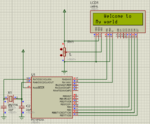Alberto Dan
Junior Member level 3

Hy i have a problem and and don't uderstand why is not work.i connect a pic 16f628A on LCD 16x2 1602A,I use microK to write the code and pickit3 to send code on pic.After i upload the code on PIC the LCD just stay open,the message not apear on it.What i can do?The code is below:
Please i need help!
Please i need help!
Code C - [expand]
Last edited by a moderator:



